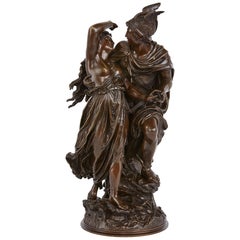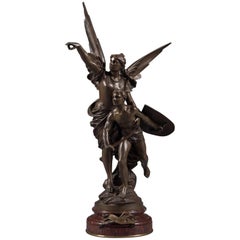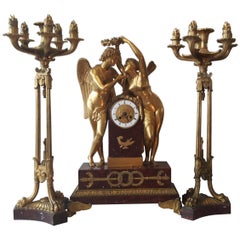L. Gregoire Furniture
to
2
2
1
1
Patinated Bronze Antique Sculptural Group of Andromeda and Perseus by Grégoire
By L. Gregoire 1
Located in London, GB
This fine antique French sculpture depicts a moment from one of the most famous tales from Classical mythology, that of Perseus and Andromeda....
Category
19th Century French Classical Greek Antique L. Gregoire Furniture
Materials
Bronze
19th Century Clock Garniture by L. Gregoire
By L. Gregoire 1
Located in Brighton, Sussex
A very impressive and striking French 19th century bronze clock garniture by L. Gregoire. Having classical silvered figures above the clock ...
Category
1860s French Antique L. Gregoire Furniture
Materials
Bronze
$38,691 / set
Related Items
Fine French Patinated Bronze Figural Group Titled Pro Patria by Edouard Drouot
By Edouard Drouot
Located in Los Angeles, CA
A very fine French antique patinated bronze figural group titled Pro Patria by Edouard Drouot
(French, 1859-1945) late 19th century.
Depicting a figure of winged Victory with a ...
Category
Late 19th Century French Late Victorian Antique L. Gregoire Furniture
Materials
Bronze
$16,250
H 30 in W 18 in D 9 in
Very Large 19th Century Clock Garniture
By Napoléon III
Located in London, GB
A wonderful garniture in marble and ormolu, the central clock face engraved in ormolu and surrounded by enameled numerals. The clock is adorned by two amorous ormolu figures of an an...
Category
Late 19th Century French Napoleon III Antique L. Gregoire Furniture
Materials
Bronze
19th Century Ormolu and Sèvres Style Porcelain Clock Garniture
By Manufacture Nationale de Sèvres
Located in LA CIOTAT, FR
This magnificent 19th-century French garniture set epitomizes the opulence and craftsmanship of the Napoleon III era, crafted in the distinguished style of Sèvres porcelain. Comprising a central mantel clock and a pair of matching candelabras, this ensemble exudes timeless elegance and artistry.
The clock showcases a lavish gilt brass case adorned with hand-painted porcelain plaques in a striking celestial blue, reminiscent of the iconic Sèvres designs. These plaques feature romantic cherubic scenes, musical motifs, and floral garlands, masterfully executed with exceptional detail. The porcelain clock face, framed by ornate gilding, is delicately painted with floral garlands and Roman numerals, signed “Marseille,” attesting to its French origin and superior craftsmanship.
The accompanying candelabras mirror...
Category
19th Century French Napoleon III Antique L. Gregoire Furniture
Materials
Brass
$3,750 / set
H 16.15 in W 10.63 in D 5.71 in
French 19th C Gilt and Patinated Bronze Group of Gloria Victis, by A. Mercie
By Antonin Mercie, F. Barbedienne Foundry
Located in New York, NY
An Incredible and Large Gilt and Patinated Bronze Group of Gloria Victis, a Winged Figure of Victory with a Fallen Warrior. This incredible bronze piece was cast after a model by Maarius-Jean-Antonin Mercié, This model is signed 'F. BARBEDIENNE FONDEUR PARIS' demonstrating that it was cast by Ferdinand Barbedienne's foundry, the best bronzier of the 19th century. The base is further signed 'A. Mercie' and stamped 'Réduction Mécanique' with an inscription of '659'. The figure is mounted on a Belgian noir marble base with various stepped edges. Gloria Victis is one the most well-known and important bronze casts of the 19th Century. The quality of this particular model is absolutely incredible and all the marking indicate that this particular piece is one of the finest produced by the Foundry.
A student of Jouffroy and de Falguière at the Ecole des Beaux-Arts, Marius-Jean-Antonin Mercié (1845-1916) won the Grand Prix de Rome at 23 years old with his work Thésée vainqueur du Minotaure. In 1872, he sent the plaster model of his work David vainqueur to the Salon, for which he won the first class medal. At the same time, he received La croix de la Légion d'honneur at the Villa Medici. His return to Paris, in 1874, issued in a long and brilliant career with numerous commissions, notably the monuments for Louis-Philippe and Queen Marie-Amélie for the Royal Chapel at Dreux (1886).
By the age of 30 Mercié was already very well-known and his Gloria Victis received resounding success when it was exhibited at the Salon, in 1874 (in plaster) and in 1875 (in bronze). This work exalted the heroism and the patriotic sentiments aroused by the disasters of 1870. His predilection for patriotic subjects is shown in many of his works such as Quand même...
Category
19th Century French Louis XVI Antique L. Gregoire Furniture
Materials
Belgian Black Marble, Bronze
$29,726
H 31.5 in W 9.5 in D 8 in
An 19th century ormolu Charles X clock garniture set.
Located in Wijnegem, BE
An exceptional ormolu Charles X clock garniture set.
France c.1830s.
Top quality!
Dimensions:
Candelabra: H76 x 21 x 21 cm.
H29.92 x 8.27 x 8.27 inch.
Cloc...
Category
1830s French Charles X Antique L. Gregoire Furniture
Materials
Ormolu
Over-Lifesize Patinated Bronze Greco Roman Standing Half-Figure of Andromeda
Located in Los Angeles, CA
A fine over-lifesize patinated bronze Greco roman revival style standing half-figure of Andromeda, probably French, probably late 19th century or early 20th century. The heavily fine...
Category
Late 19th Century French Greco Roman Antique L. Gregoire Furniture
Materials
Bronze
$124,850
H 61.5 in W 22 in D 20 in
Fine 19th Century Clock Set Garniture by Jacob Petit
By Jacob Petit
Located in London, GB
An elegant Rococo garniture by Jacob Petit, Paris, circa 1860. The clock is elaborately hand-painted with flower cartouches, as are the matching vases and a pair of Meissen style figurines, depicting gardners adorn the foot of the clock. The clock and its matching vases with their lattie-edged rims rest on bases rather than on porcelain feet.
Category
Late 19th Century French Rococo Antique L. Gregoire Furniture
Materials
Porcelain
Gilt Bronze Sevres Style Clock Garniture, 19th Century
Located in Boven Leeuwen, NL
Beautiful 18th century Rococo manner gilt bronze mantel clock with elegant Sèvres style bleu / navy colored porcelain.
The porcelain is very delicately hand painted with a landscape on one side of the vases and figures on a staircase on the other.
Gorgeous gold details on a deep blue and jeweled background.
The clock has a painting on the top with 2 ladies...
Category
Late 19th Century French Rococo Antique L. Gregoire Furniture
Materials
Bronze
$6,184 Sale Price / set
20% Off
H 18.12 in W 12.21 in D 5.12 in
A Continental 19th century Bronze and Marble statue of Perseus and Medusa
Located in West Palm Beach, FL
An exceptional Continental 19th century Grand Tour Period patinated Bronze, Black Belgian, and Rosso Alicante marble statue of Perseus and Medusa. This handsome statue of Perseus hav...
Category
19th Century Unknown Grand Tour Antique L. Gregoire Furniture
Materials
Marble, Bronze
$10,780
H 20.5 in W 6.5 in D 4.75 in
19th Century French Rouge Marble & Ormolu Clock Garniture
Located in Dublin, IE
A fine 19th Century French Clock Garniture, the Clock with bronze solider surmounted on a domed top with urn finials on four rouge marble pillars, over pierced decorated base on a sh...
Category
19th Century French Louis XIV Antique L. Gregoire Furniture
Materials
Griotte Marble, Ormolu
$17,423 / set
H 21.5 in W 10.52 in D 7.01 in
19th Century Antique French Neoclassical Style Gilt Bronze Clock Garniture
Located in Dublin, IE
An exceptional quality three-piece clock set designed in a grand neoclassical style by 'Domange Rollin Rue de Bretagne Paris'. France.
The set is comprised of a central clock and tw...
Category
19th Century French Louis XVI Antique L. Gregoire Furniture
Materials
Enamel, Ormolu
$20,515 / set
H 20.08 in W 14.18 in D 5.91 in
Monumental 19th Century French Three-Piece Ormolu Clock Garniture
Located in New York, NY
A fine quality monumental gilt bronze three-piece clock garniture.
Comprising a fine quality large gilt bronze eight-arm figural rococo candelabra a...
Category
Late 19th Century French Antique L. Gregoire Furniture
Materials
Ormolu, Bronze
$48,000 / set
H 32 in W 29 in D 10 in
L. Gregoire furniture for sale on 1stDibs.
L. Gregoire furniture are available for sale on 1stDibs. These distinctive items are frequently made of metal and are designed with extraordinary care. There are many options to choose from in our collection of L. Gregoire furniture, although gold editions of this piece are particularly popular. If you’re looking for additional options, many customers also consider furniture by and August Moreau. Prices for L. Gregoire furniture can differ depending upon size, time period and other attributes — on 1stDibs, these items begin at $2,495 and can go as high as $34,685, while a piece like these, on average, fetch $11,991.



